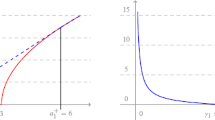Abstract
We consider the portfolio optimization problem for the criterion of maximization of expected terminal log-utility. The underlying market model is a regime-switching diffusion model where the regime is determined by an unobservable factor process forming a finite state Markov process. The main novelty is due to the fact that prices are observed and the portfolio is rebalanced only at random times corresponding to a Cox process where the intensity is driven by the unobserved Markovian factor process as well. This leads to a more realistic modeling for many practical situations, like in markets with liquidity restrictions; on the other hand it considerably complicates the problem to the point that traditional methodologies cannot be directly applied. The approach presented here is specific to the log-utility. For power utilities a different approach is presented in the companion paper (Fujimoto et al. in Appl Math Optim 67(1):33–72, 2013).
Similar content being viewed by others
Notes
We are grateful for an anonymous suggestion of this useful norm.
References
Atar, R., Zeitouni, O. (1997). Exponential stability for nonlinear filtering. Annales de l’Institut Henri Poincare (B) Probability and, Statistics, 33, 697–725.
Bäuerle, N., & Rieder, U. (2011). Markov decision processes with applications to finance. Berlin: Springer, Universitext.
Björk, T., Davis, M. H. A., & Landén, C. (2010). Optimal investment under partial information. Mathematical Methods of Operations Research, 71, 371–399.
Bremaud, P. (1981). Point processes and queues: Martingale dynamics. New York: Springer.
Capponi, A., & Figueroa-Lopez, J. E. (2013). Power utility maximization in hidden regime-switching markets with default risk. http://arxiv.org/abs/1303.2950
Callegaro, G., Di Masi, G. B., & Runggaldier, W. J. (2006). Portfolio optimization in discontinuous markets under incomplete information. Asia Pacific Financial Markets, 13(4), 373–394.
Cvitanic, J., Liptser, R., & Rozovski, B. (2006). A filtering approach to tracking volatility from prices observed at random times. The Annals of Applied Probability, 16, 1633–1652.
Cvitanic, J., Rozovski, B., & Zaliapin, I. (2006). Numerical estimation of volatility values from discretely observed diffusion data. Journal of Computational Finance, 9, 1–36.
Elliott, R. J., Aggoun, L., & Moore, J. B. (1995). Hidden Markov models: Estimation and control. New York: Springer.
Frey, R., & Runggaldier, W. (2001). A nonlinear filtering approach to volatility estimation with a view towards high frequency data. International Journal of Theoretical and Applied Finance, 4, 199–210.
Fujimoto, K., Nagai, H., & Runggaldier, W. J. (2013). Expected power-utility maximization under incomplete information and with Cox-process observations. Applied Mathematics and Optimization, 67(1), 33–72.
Gassiat, P., Gozzi, F., & Pham, H. (2011a). Investment/consumption problems in illiquid markets with regimes switching (preprint).
Gassiat, P., Pham, H., & Sirbu, M. (2011b). Optimal investment on finite horizon with random discrete order flow in illiquid markets. International Journal of Theoretical and Applied Finance, 14, 17–40.
Goll, T., & Kallsen, J. (2003). A complete explicit solution to the log-optimal portfolio problem. The Annals of Applied Probability, 13, 774–799.
Grandell, J. (1991). Aspects of risk theory. New York: Springer.
Le Gland, F., & Oudjane, N. (2004). Stability and uniform approximation of nonlinear filters using the Hilbert metric, and application to particle filters. Annals of Applied Probability, 14(1), 144–187.
Liverani, C. (1995). Decay of correlations. The Annals of Mathematics, 142(2), 239–301.
Matsumoto, K. (2006). Optimal portfolio of low liquid assets with a log-utility function. Finance and Stochastics, 10, 121–145.
Nagai, H. (2004). Risky fraction processes and problems with transaction costs. In J. Akahori et al. (Ed.), Stochastic processes and applications to mathematical finance (pp. 271–288) World Scientific.
Pham, H. (2011). Portfolio optimization under partial information: Theoretical and numerical aspects. In D. Crisan & B. Rozovskii (Eds.), The Oxford handbook on nonlinear filtering (pp. 990–1018). Oxford: Oxford University Press.
Platen, E., & Runggaldier, W. J. (2007). A benchmark approach to portfolio optimization under partial information. Asia Pacific Financial Markets, 14, 25–43.
Pham, H., & Tankov, P. (2008). A model of optimal consumption under liquidity risk with random trading times. Mathematical Finance, 18, 613–627.
Pham, H., & Tankov, P. (2009). A coupled system of integrodifferential equations arising in liquidity risk models. Applied Mathematics and Optimization, 59, 147–173.
Rogers, L. C. G., & Zane, O. (2002). A simple model of liquidity effects. In K. Sandmann & P. Schönbucher (Eds.), Advances in finance and stochastics, essays in honour of Dieter Sondermann (pp. 161–176). Berlin: Springer.
Taksar, M., & Zeng, X. (2007). Optimal terminal wealth under partial information: Both the drift and the volatility driven by a discrete-time Markov chain. SIAM Journal on Control and Optimization, 46(4), 1461–1482.
Author information
Authors and Affiliations
Corresponding author
Additional information
The opinions expressed are those of the author and not those of The Bank of Tokyo-Mitsubishi UFJ.
Appendix
Appendix
Proof of Lemma 4.1
Proof of statement (i). It follows from the two lemmas shown below.
Lemma 5.1
We have the following representation,
Proof
It suffices to prove that for any \(\mathcal{G }_t-\)adapted process \(Z_t\)
First notice that any \(\mathcal{G }_t-\)adapted process \(Z_t\) has the representation (see Bremaud 1981)
with the process \(Z_k(t)\) being \(\mathcal{G }_k \otimes \mathcal{B }(\mathbb{R }_+)\)-measurable. Furthermore, under our assumptions, for all \(t>0, \lim _{n\rightarrow \infty }1_{ \{ \tau _n < t\} } =0\) and thus
Note, finally, that \(E\left[ 1_{\{\tau _k< t\le \tau _{k+1} \}} |\mathcal{G }_k \right] =1_{]\tau _k, \infty )} (t) E[1_{\{ t\le \tau _{k+1} \}}|\mathcal{G }_k ]] \). We then have
and thus we obtain (5.2) since
which follows from (2.16). \(\square \)
Lemma 5.2
We have the following equation
with \(\hat{C}(t,\pi ,h)\) defined by (4.6) in Definition 4.1.
Proof
For simplicity, in the following formula we shall use the notation
Using (5.1) we have similarly as above
Since \(\left( \theta _t, \tilde{X}_t\right) \) is a time homogeneous Markov process,
We now have, recalling the definition of \(r_{ji}(t,z)\) in (3.8),
We finally have
\(\square \)
Proof of statement (ii) of Lemma 4.1.
We start by proving that \(\hat{C}(t,\pi , h)\) is Lipschitz continuous with respect to \(t\).
Thus
where \(\Vert f \Vert := \sup _{e\in E, h\in \bar{H}_m}\Vert f(e, h) \Vert \). Next, let us prove that \(C(t,\pi , h)\) is Lipschitz continuous with respect to \(\pi \) [in the metric introduced in (3.21)].
where we have used (3.20).
Next, let us prove that \(C(t,\pi , h)\) is continuous with respect to \(h\) [always in the metric introduced in (3.21)]. The function \(f(e_i,h)\) is bounded and continuous with respect to \(h\) for all \(i\). Furthermore, \(\gamma (x,h)\) is continuous with respect to \(h\) for all \(x\in \mathbb{R }^m\). Applying the dominated convergence theorem, for \(\ {h_n}\subset \bar{H}_m\), s.t.\(\displaystyle \lim _{n\rightarrow \infty } h_n =h\in \bar{H}_m\)
\(\hat{C}(t,\pi , h)\) is thus continuous with respect to each of the variables \(t,\pi ,h\). However, continuity in \(t,\pi \) is independent of the other variable. Hence, \(\hat{C}(t,\pi , h)\) is a continuous function on \([0,T]\times \mathcal{S }_N \times \bar{H}_m\).
Proof of Lemma 4.2
Fix \(n\ge 0\). Recall the definition of \( h_{n}^i\) given in Sect. 2.3. Since \(S_t\) is continuous and \(V_t\) satisfies the self-financing condition, we obtain
Using (2.16), (2.18), for \( all \ k\ge 1,h \in \mathcal{A }^{n},t\in [\tau _{n+k},T]\), one furthermore has
Therefore, using lemma 4.1(i) for \(\ h\in \mathcal{A }^n\)
Proof of Lemma 4.6
By the definition of \(\mathcal{A }^n\), for \(n\ge 0, \mathcal{A }^n\subset \mathcal{A }^{n+1} \subset \mathcal{A }\), hence,
By the definition of \(W^{n}(t,\pi ) \) and \(W(t,\pi ) \)
Using Lemma 4.5, for \(\ n,m\ge 0\)
Letting \(m\rightarrow \infty \)
Proof of Lemma 4.7
For\( \ h \in \mathcal{A }, W(t,\pi ,h)\) defined by (4.8) satisfies
because of the representation of \(W^n(t,\pi )\) in Corollary 4.2 (Eq. 4.13) and Lemma 4.5. Thus, by letting \(n \rightarrow \infty \), we obtain
for all \( \ h \in \mathcal{A }\).
Rights and permissions
About this article
Cite this article
Fujimoto, K., Nagai, H. & Runggaldier, W.J. Expected Log-Utility Maximization Under Incomplete Information and with Cox-Process Observations. Asia-Pac Financ Markets 21, 35–66 (2014). https://doi.org/10.1007/s10690-013-9176-1
Published:
Issue Date:
DOI: https://doi.org/10.1007/s10690-013-9176-1




